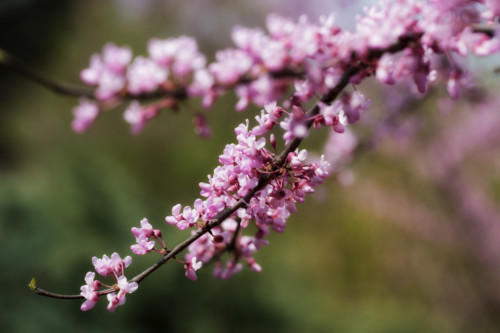Fairytale Trees Every Gardener Should Know
Why should flowers get all the glory? Any garden’s biggest showstopper are the trees, and this time of year some of the best and brightest specimens are in bloom. Magnolias, Dogwood, even the common Crabapple trees are bursting forth with color– but there’s a lot more to the story than just beautiful blossoms. Read on about the folkloric science surrounding Spring’s most popular trees.
Eastern Redbud – Cercis Canadensis
Every spring, the blossoming of the Eastern Redbud signals the arrival of warm weather with a vibrant display of purple, pink and red blooms that are the floral equivalent of fireworks. Eastern Redbud was admired for centuries by Native Americans (who used Redbud bark for bows) as well as folk healers (who nicknamed Redbud the “Judas Tree” and used its buds to treat dysentery and leukemia). Today, its popular among landscape designers and garden aesthetes alike, revered mostly for the color and dimension it adds to a landscape– but you can also eat the flowers (which are nutty and make a beautiful garnish) and the pods (which can be cooked with butter just like peas). Redbud offers some of the most vibrant, naturally-occurring color in nature: these handsome trees look fantastic by themselves on the lawn, as an arcade along a path, or among shrubs of a different color. They’re stunning even in the wintertime, when their darkened branches cast strong silhouettes against stark winter skies (architects also love using it to buffer flat building facades). As a low-maintenance America native, Redbud rarely grows taller than 30 feet, so it’s super easy to maintain.
Flowering Dogwood – Cornus Florida
Ah, Dogwood! Nothing signifies a quintessential American spring like the Flowering Dogwood tree, which is the state flower of North Carolina and Virginia. Artisans frequently use the trees’ branches for spools, pulleys, mallets, and blocks because its a soft wood that’s excellent for carving. Dogwood is a pyramidal tree that reaches heights of up to 40 feet, with profuse white blooms arriving around May (some hybridized varieties may be pink or red, like the specimen above). The fruit in the middle of each flower (which grows in tiny drupe clusters) is an important food source for many North American birds. Make sure to plant it in deep, damp soil; Dogwoods struggle in shallow, dry or rocky soil, and may suffer leaf-scorching under the harsh sun– this is why there’s sometimes a southern association with this tree, though it can be seen in the late spring in many New England yards. Come fall, the striking green leaves shift to a striking crimson, an autumnal hallmark.
Crabapple – Genus Malus
Commonly referred to as the “wild apple tree”, the crabapple family has earned the Royal Horticultural Society’s “Award of Garden Merit” (because yes, that exists). The trees play in important role in supporting cross-pollinators like bumble bees, even if the fruit these blossoms later yield isn’t exactly for its taste. New Englanders sometimes use crabapples to make Crabapple jam, but the apples themselves are typically much smaller than their grocery store cousins, and they are very, very sour (add them to homemade cider for an unexpected tang). They are also an excellent source of pectin, which is a critical ingredient in most jams and jellies, and the smoke from crabapple firewood adds great flavor and depth to smoked meats. Still, Crabapple trees are much more often celebrated for their mid-spring proliferation of red, pink, and white flowers. (Again, that’s why Horticultural Societies love them.) Crabapple is fantastically-resistant against disease and drought, and typically only grows to about 15 feet tall. They do well in full sun with well-draining soil, and have thin, flexible branches that can be trained into espaliered shapes that look amazing in bloom– plant them next to a slotted railing and you’ll have a deck full of flowers come spring.
Magnolia – Genus Magnolia
Magnolias are some of the most ancient trees on planet earth– according to conventional taxonomy, they’ve been around since before bees existed. (Fossils of plants belonging to Magnoliaceae have been dated back 95 million years.) Today, the modern Magnolia is stunning, from its showy flowers (in white, pink, red, purple, and yellow; oh my!), to their lustrous waxy leaves and pinecone-like fruit pods. Magnolia trees also have ample, shady boughs that feel somehow more majestic than other flowering trees, possibly due to their Jurassic lineage. Unfortunately, Magnolia is also super picky, requiring mild temperatures and acidic soils. Although some horticulturalists have developed hardy specimens capable of withstanding more temperate climes, the hard freezes and long winters of more northerly states pose a significant roadblock to folks in the Northeast. Magnolia’s relative weakness as saplings recedes as the plants mature into thick, dignified trunks; a fully-grown magnolia tree can shrug off mild to moderate drought without a problem. Often a staple in southern gardens, Magnolias are hard work to maintain– but their beauty come spring is totally worth it.






































